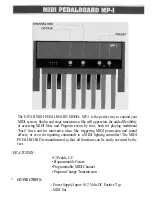
Descriptions of Parameters
Setup Editor Parameters
5-9
The Key Range Menu
Low and Hi
The primary function for the Key Range menu is determining where a zone plays on the
keyboard. This is controlled by the values of the Low and Hi parameters. In the default setup, all
zones range from C -1 to G 9. An 88-note keyboard ranges from A 0, to C 8 (and a 76-note
keyboard from E 1 to G 7), but you can transpose a zone so that it sends note numbers below or
above those rangesÑit wonÕt generate notes, but itÕll still generate MIDI information, which can
be useful).
The PC2 ignores the values of these parameters when the AutoSplit parameter has a value of
On
(the values appear in parentheses to indicate that these parameters are inactive. When AutoSplit
is set to On, the value of the AutoSplit Key parameter determines the split points for all the
zones in the setup (Zones 3 and 4 cover the region from the bottom of the keyboard up toÑand
includingÑthe split point, while Zones 1 and 2 cover the region from the top of the keyboard
down to the note above the split point).
Intuitive entry makes it easy to edit these parameters; just hold down the
Enter
button and
strike a key to set the value.
Note Map
This parameter determines how the PC2 responds to each note on the keyboard. If youÕre using
the PC2 as a solo instrument, youÕll probably never need to edit the note map for the internal
setup. If you play a lot of setups, or control external instruments, different note maps can be
useful in a number of ways.
In the default setup, each zone has a value of
Linear
for Note Map. This gives you a normal
keyboard: playing C 4 triggers the note C 4, just as you would expect. Assuming the zoneÕs Dest
parameter is at its default value of
Local+MIDI
, every note you play goes both to the PC2 and to
the MIDI Out port.
If the value of Note Map is Off, the PC2 generates no note information, but still generates all
non-note information like MIDI Controller messages.
The next group of valuesÑ
1 of 2
through
4 of 4
Ñgenerate note information only for speciÞc
notes. We call these alternating note maps. TheyÕre handy when playing a setup that sends MIDI
information to multiple external instruments, because they enable you to play the external
instruments as if they were a single instrument, thereby increasing your available polyphony.
A value of
Inverse
reverses the keyboard: high notes at the bottom and low notes at the top. A
value of
Constant
causes all the keys to play the same note. By default this is C 4, but you can
change it with the Transpose parameter. Setting a zoneÕs Note Map parameter to
Constant
is
useful when you want the sound from a particular note to play with every note of another
zoneÑfor example, playing a ride cymbal with every note in a bass line.
AutoSplit
Turns the AutoSplit feature on and off
for all zones in the setup
. In the default setup, this value is
Off
. The AutoSplit feature is intended primarily for making quick layers and splits from an
Internal-Voices program, but enabling AutoSplit for a setup is useful if you like to solo and mute
zones while performing. See
The AutoSplit Feature
on page 3-20 for more information.
















































